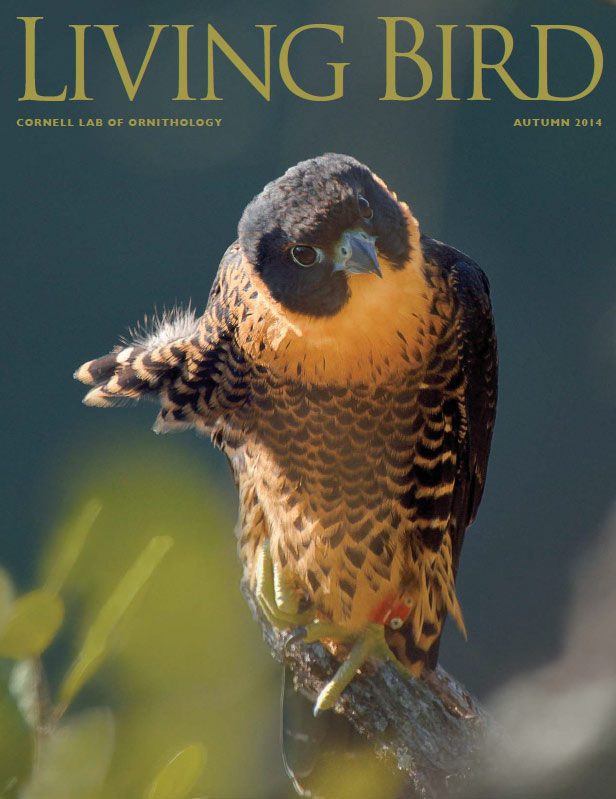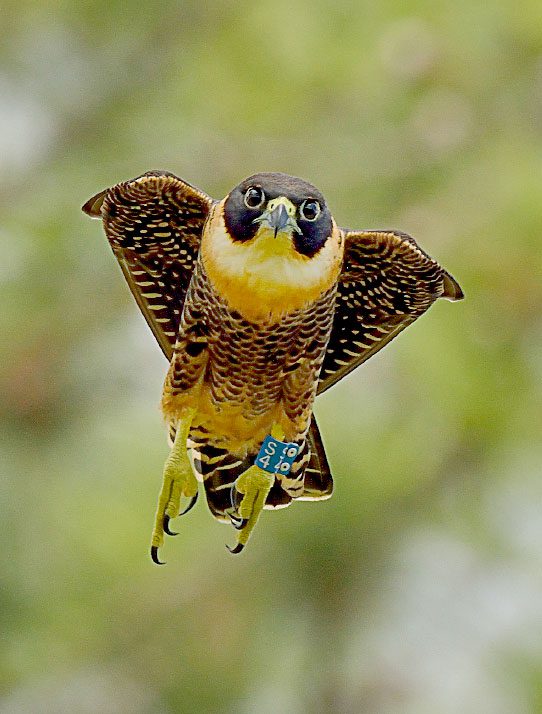Rescuing the Orange-breasted Falcon, Icon of the Rainforest
By Robert B. Berry
From the Autumn 2014 issue of Living Bird magazine.
Orange-breasted Falcon. Photo by Chris Wood. October 15, 2014There’s a single chick in the nest,” Aaron radioed as he hung from a rope on a lofty cliff in Belize. “Should we take it?” He had climbed hundreds of feet down to an Orange-breasted Falcon eyrie to retrieve fledglings on behalf of The Peregrine Fund for experimental captive propagation.
“No,” I replied, feeling guilty about his arduous descent to the nest. “Come on back up.” Taking the last young falcon from the nest would be unethical.
A brief electrical storm delayed Aaron’s ascent and forced all three of us to hunker against the cliff. Then we heard the muffled cry, “Bees!” as Aaron emerged amid a cloud of angry Africanized “killer” bees that obscured his face. “Cut the damn rope!” he shouted, spitting bees from his mouth. Free of the rope, Aaron bolted for the safety of a nearby waterhole, with Oscar and I close behind, tripping and stumbling in a futile effort to outrun the angry horde. We plunged into the water, but whenever we surfaced, the bees attacked, and no amount of splashing deterred them. A waterfall at the head of the pool was shallow enough for us to stand under its protective veil. We were safe, temporarily, but the choice was clear—we must either escape from the bees or perish from hypothermia under the waterfall. I finally burst out the opposite side of the waterfall, scaled a small cliff, and crawled rapidly through the tall “dumb grass,” oblivious to stings from a few scouts. My comrades followed.
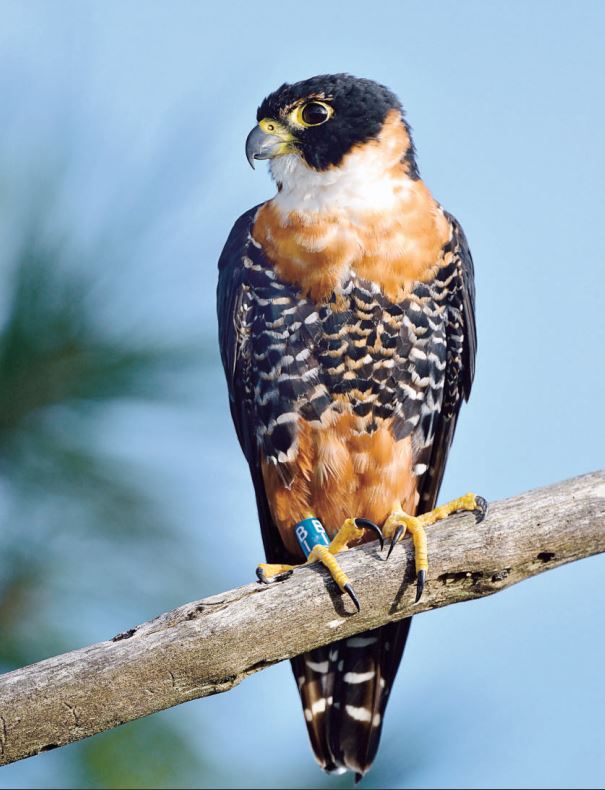
Aaron spent the night at a medical clinic, soaking up antihistamines, while Oscar and I sat at camp, removing each other’s stingers like a pair of chimpanzees picking lice. We waited until after dark to collect our gear at the cliff, after the bees had settled down. Unaware that highly aggressive Africanized bees had displaced the mild-mannered European honeybees a decade earlier, we were fortunate to escape serious injury or worse. This episode took place at Belize’s Thousand Foot Falls in 1994, during the initial phase of our Orange-breasted Falcon research in Central America.
History and Research
Only a few decades ago, our knowledge of the Orange-breasted Falcon (Falco deiroleucus) was limited to a few sight records in the literature and some sketchy notes attached to 19th and early 20th-century museum specimens and a single breeding record in Tikal National Park, Guatemala. In 1978, Tom Cade, founder and president of The Peregrine Fund, and biologist Peter Jenny assembled sparse geographic information and began searching for the species in Ecuador, Peru, and Guatemala. From the early 1980s through 1991, researchers conducted studies of newly located territories in Guatemala and Belize as part of the Maya Project, a nearly decade-long (1988-96) ecological raptor study (see Neotropical Birds of Prey: Biology and Ecology of a Forest Raptor Community). Graduate student Aaron Baker was part of the project and began the first natural-history study of the Orange-breasted Falcon in 1992. He searched for cliffs by questioning local people, examining topographical maps, and exploring river valleys and areas of high relief on foot, by car, and from fixed-wing aircraft. By 1996 Baker had expanded his study population to 19 territories in Belize and Guatemala. Our present-day research and restoration program builds upon this series of earlier investigations.
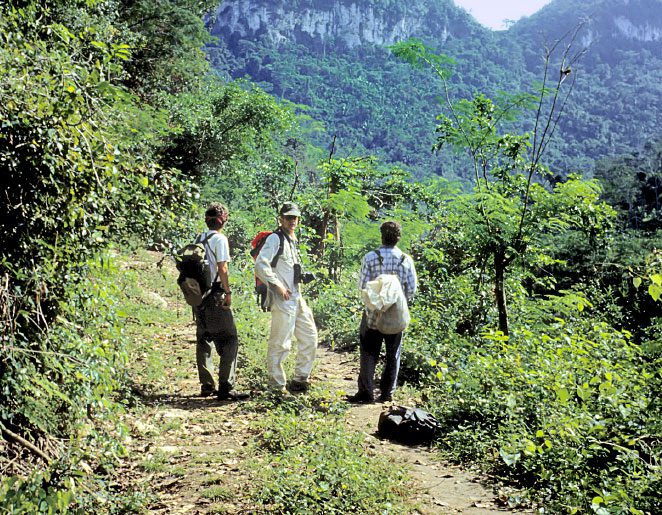
Peregrine Fund president Bill Burnham asked me to visit Baker to explain the breeding biology of the Orange-breasted Falcon. I had never seen the bird, but I had lots of experience breeding falcons in captivity. Early in March of 1992, Aaron and I were sprawled on a massive boulder in the middle of the Macal River, in the shadow of a gigantic cliff—an irresistible ecological magnet for falcons and one of Aaron’s Orange-breasted Falcon territories. Armed with binoculars and a spotting scope, we scanned the sky for raptors. As if by magic, a male Orangebreasted Falcon appeared above us, spiraling effortlessly upward in the noonday thermals until it became a tiny speck. An instant later, it came plummeting earthward in a blistering vertical stoop, climaxed by streaking across the cliff face, its defiant kak-kak-kak call echoing between the towering canyon walls. Then it rocketed off in a different direction to chase a Black Vulture and next a Plumbeous Kite. It was the most spectacular and inspiring aerial performance I had ever seen in a lifetime of working with falcons. What bravado and courage he showed. Surely the bird was reassuring his unseen mate and serving notice that this was his domain and he was invincible.
I was hooked! But I could not have imagined that the next year I’d be dangling on a rope from the top of this massive precipice, at the beginning of a lifelong journey.
Aaron spent the next six years studying the Orange-breasted Falcon. His field research became the seminal life-history study of the species. He concluded that the local population was probably stable—but just barely—and part of a larger unknown population (Baker et al. 2000). It was not until the end of the decade that we concluded that the northern population was very small, isolated, and in steep decline.
Identification, Status, and Distribution
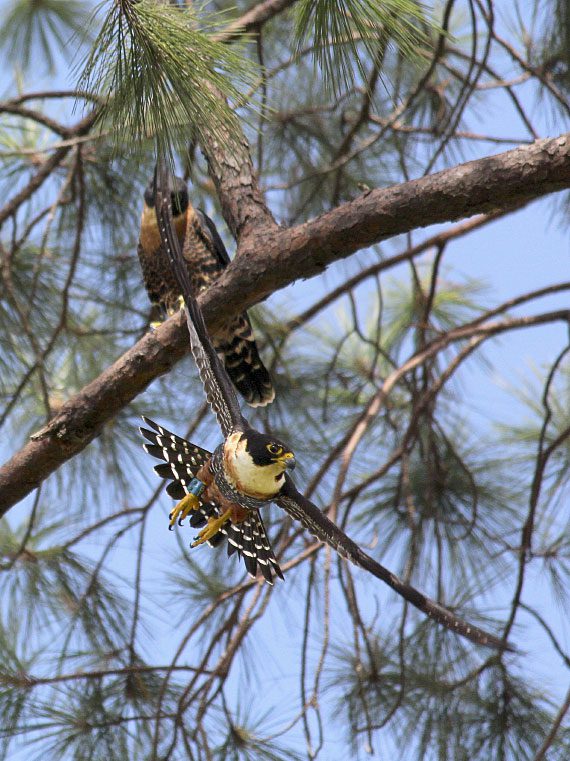
The Orange-breasted Falcon is a brilliantly colored medium-sized falcon of the contiguous Neotropical forest, arguably the most beautiful species of falcon, and the Holy Grail for many tropical birders. It has always been rare and may be the most sparsely distributed falcon in the world, with its abundance and distribution clouded by confusion with the much more common and similarly plumaged Bat Falcon. The International Union for Conservation of Nature lists the Orange-breasted Falcon as “near threatened” globally in its Red List of Threatened Species. Once ranging from southern Mexico through Middle and South America, the species is now regionally endangered or extirpated in Central America (Berry et al.).
The Northern Population
The Orange-breasted Falcon’s history in Middle America is documented by only 10 museum specimens collected between 1867 and 1962 from Mexico to Costa Rica, a few confirmed sightings, and a single breeding record. Our surveys over several decades confirm that the species’ northern population is limited to the Maya Mountains of Belize and the Mirador Cordillera of Guatemala—an area comprising less than 4 percent of its former range in Central America. Orange-breasted Falcons are isolated by some 1,500 kilometers from the closest population of not more than four pairs on the Colombian border of Panama, which we survey annually. Despite a wide network of contributors, eBird has been unable to confirm a single Central American record for this species outside our study area.
The Maya Mountains of western Belize and the Mirador Cordillera of Guatemala are home to the largest and densest known Orange-breasted Falcon population, which includes 32 territories. Seven of them have been abandoned for more than a decade. Aerial surveys in 2009 and 2010 located 10 additional eyries in the rugged and remote southern Maya Mountains, which are only accessible by helicopter. The massif is 75 miles long by 40 miles wide with a northeast-southwest orientation extending about 20 miles into heavily developed eastern Guatemala, where the falcons are absent.
Our core study population is in the Mountain Pine Ridge of the northern mountains, a small granite plateau of about 200,000 acres, with an elevation between 600 and 900 meters. The plateau is dominated by pines and dissected by streams and deep hardwood canyons extending into valleys with abundant limestone and granite cliffs, a few of which are occupied by Orange-breasted Falcons. The forest life zone is borderline tropical-subtropical moist to wet forest. Both the falcon and its prey breed during the dry season, from February through May, a period with the highest temperatures and lowest rainfall.
Six pairs reside in Guatemala, all in the Petén Department, which includes Tikal National Park. The topography is gently rolling, broken in a few areas by steep karst terrain with few large escarpments, limiting the abundance of the falcons. Elevations range from 100 to 300 meters. The climate is lowland tropical, warmer and wetter than the mountains of Belize. The warm, moist tropical environment, coupled with a pronounced dry season for nesting, may be critical ingredients for the falcon’s specialized niche.
Natural History
Orange-breasted Falcons occupy their territories year-round and typically are found in areas of towering cliffs within vast expanses of moist tropical and subtropical mature forest in the vicinity of water. Cliffs in Belize and Guatemala are large (typically 125 meters high and 250 meters wide) with obscure ledges, potholes, and crevices, which provide shade from the blazing tropical sun and safety from predators. There are few tree-nesting records, possibly because trees offer less protection from predators and the sun’s heat. The species is not known to nest in tropical savannah—suitable habitat for lookalike species such as Bat and Aplomado falcons. Some researchers suggest that Orange-breasted Falcons are birds of edges, borders, and clearings adjacent to montane forest, which may offer more rewarding hunting opportunities. We have found that the species does frequent a mosaic of habitats, including farmed fields, orchards, and pasturelands—but only if mature forest is the dominant community.
Many tropical raptors—including the closely related Bat Falcon—hunt within the forest canopy. The Orange-breasted Falcon is unique in hunting above the canopy, the most challenging environment for a bird-eating specialist. The birds have long, narrow, pointed wings, a relatively short tail, and a heavy compact body with a deep sternum, supporting powerful flight muscles. These features maximize speed as opposed to maneuverability, for preying on a wide variety of small-to-medium-sized birds and bats, which are captured in high-speed stoops when they are briefly exposed above the forest canopy or while crossing a canyon, stream, or river valley. The female Orange-breasted Falcon is the most heavily armed of falcons, possessing a massive, laterally compressed beak, thick powerful legs, and enormous feet relative to its body size—important attributes for grasping and quickly dispatching dangerous quarry such as parrots. Males are half the size of their mates and lack their impressive armature, a difference that supports the female’s dominant role in social relations, nest defense, and exploitation of a varied prey base.
Current Research
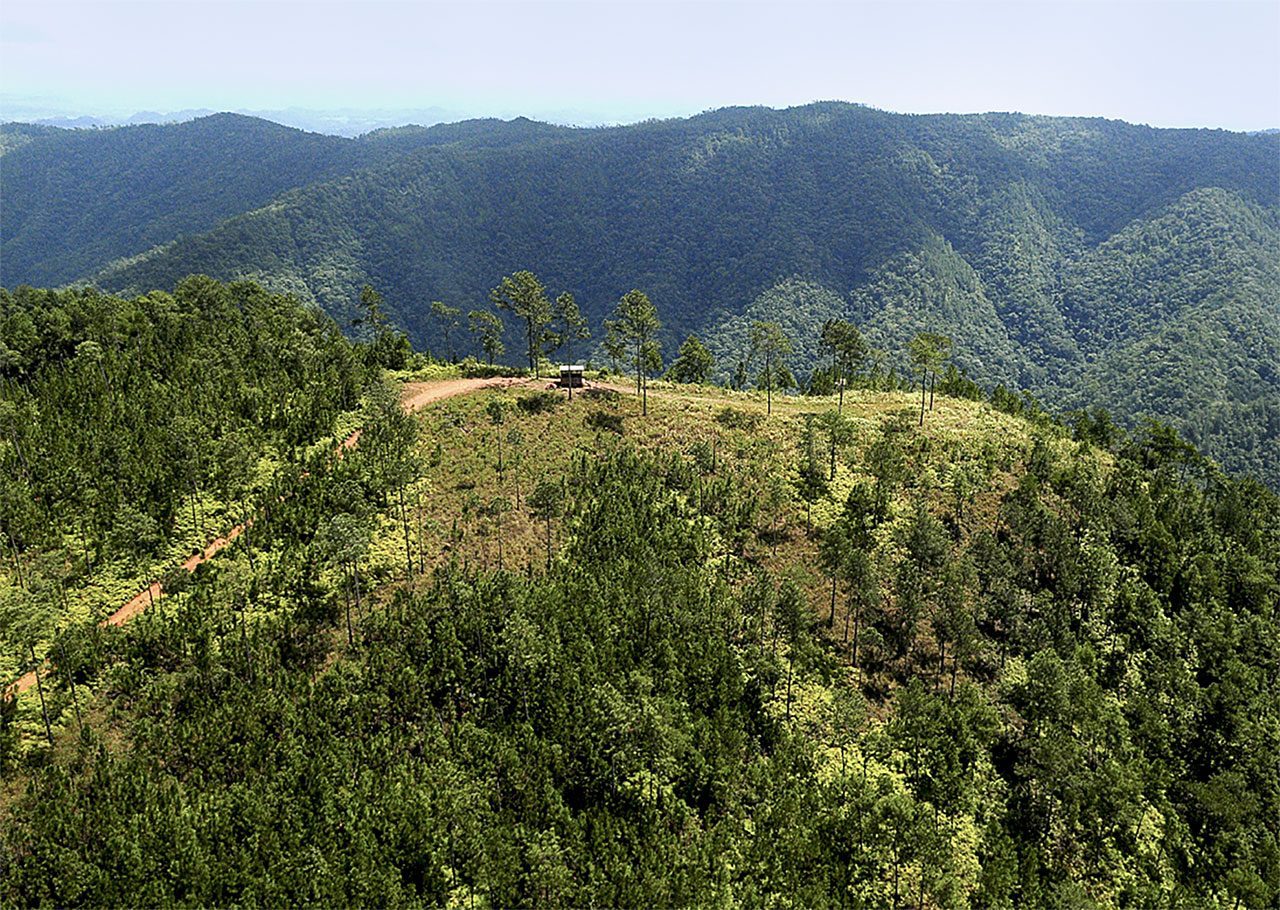
Following Aaron Baker’s landmark 1992-97 study, The Peregrine Fund resumed surveys in 2003 under my direction. We doubled the number of known eyries in Belize to 25, which includes a new territory founded by one of our captive-bred males and a wild female in 2013. We had earlier added a new territory in Guatemala in 2008, the first located since the 1990s, for a total of 32 current and historic sites. We are able to access 21 of these territories on foot. We banded a record 14 of 15 fledglings in 2013, and collected blood feathers to measure genetic diversity, fitness, and connectivity between the wild and captive populations using microsatellite analysis.
Scott Newbold leads our current field team, aided by local naturalists Jonathan Urbina and Rony Jobel and our rock-climbing specialist Matt Allshouse. They visit Orange-breasted Falcon territories multiple times each season to assess occupancy and productivity. Africanized bees limited our banding activities prior to 2011, when we began using full-body bee suits despite the heat and discomfort. We use color-coded leg bands with white letters and numerals as safe and permanent markers for future demographic studies. We do not capture adults or use radio telemetry because of the inherent risks to the small, fragile population. We rely on old-fashioned fieldwork, with the aid of boots, binoculars, and bug spray!
Population Dynamics
Species that are highly specialized ecologically and have small, isolated populations are prone to population declines and local extirpation. Both territorial occupancy and productivity in our core study population in Belize have dropped by half since the 1990s. The number of eyries has fallen from 12 to 6 with only 2 failed attempts to reoccupy one of the eyries. Productivity in Belize and Guatemala was close to one young per active eyrie in the 1990s but has declined to ~ 0.5 since 2003 (Berry et al. 2010). Productivity in both countries has been highly variable in recent years with a record low of only two young fledged in 2012, 15 in 2013 (including 5 young with a captive-bred parent), and back to a more typical 8 young in 2014 fledged from 15 eyries. The maintenance level for the well-studied Peregrine Falcon is more than double with one or more young per active eyrie. Whether an extraordinary year now and then like the one we experienced in 2013 is sufficient to sustain a long-lived species such as the Orange-breasted Falcon is unknown. If that good year does not materialize, the risk of entering an extinction vortex is great.
Natural Predators
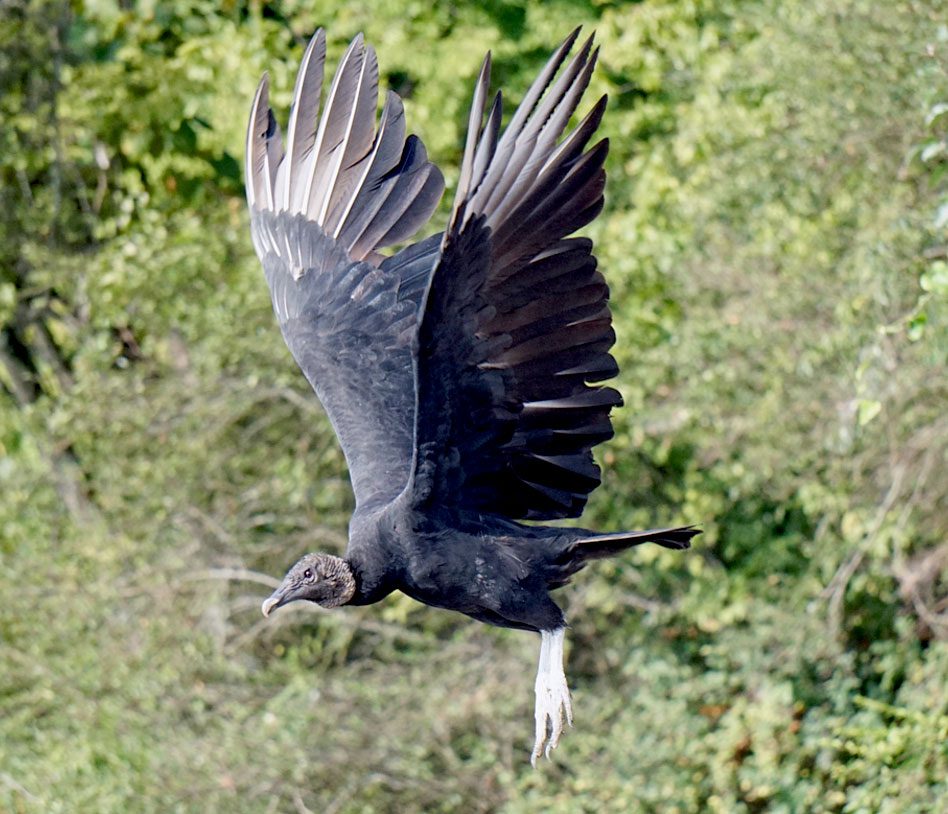
Aaron Baker calculated that 55 percent of Orange-breasted Falcon nesting attempts failed and that predators caused most of the failures. The list of potential predators is enormous, from jays and toucans to hawk-eagles, owls, forest-falcons, and vultures; mammals such as the tayra (a large mustelid) and rats; arboreal snakes, insects, and parasites. Prominent on the list are the Black-and-white Hawk-Eagle, Stygian Owl, and Black Vulture. Of them, the Black Vulture is the most ubiquitous and is increasing in numbers along with the human population. A group of vultures can overpower a falcon’s aggressive defense and consume its eggs or young. They also usurp prime nesting cliffs. More predatory than the Turkey Vulture and the much less common King Vulture, they forage by sight, attacking and killing small animals and fledgling birds.
The Black-and-white Hawk-Eagle might be the greatest threat to juvenile Orange-breasted Falcons, both wild and captive-bred. This spectacular species is widespread from Mexico to Argentina but is uncommon and secretive in the Mountain Pine Ridge of Belize. It is extremely rare in Guatemala—which, by itself, may account for the stability of the country’s small Orange-breasted Falcon population.
Human Threats
The Orange-breasted Falcon is not known to nest apart from mature forest, although we do not know the point at which fragmented habitat becomes uninhabitable or why. Small farms, orchards, and cattle ranches caused the abandonment of at least one historic territory and threaten others. Construction of three hydroelectric dams along the Macal River are implicated in the loss of two of four falcon territories. The last of these construction projects was completed in 2012, with human traffic limited, although a massive infrastructure of power lines presents a high risk of falcon collisions and electrocutions. Even well-meaning tourists may have a negative impact by disrupting nesting.
Two of six occupied territories in Guatemala are located outside Tikal National Park and have no protection. They are threatened by rapidly expanding rural communities with a much higher rate of deforestation, colonization, agriculture, and subsistence hunting than in Belize. Even though falcon occupancy and productivity have been more stable in Guatemala than Belize, the inevitable correlates of human progress are likely to have a greater negative impact over time.
We believe that the Orange-breasted Falcon’s primary extinction drivers are habitat alteration and associated human activities, which include indiscriminate shooting, logging, agriculture, and development. These drivers interact with the impacts of human disturbance, such as increased access to remote habitat, hunting, tourism, selective logging, and collecting, further exacerbated by interactions with the bird’s natural predators.
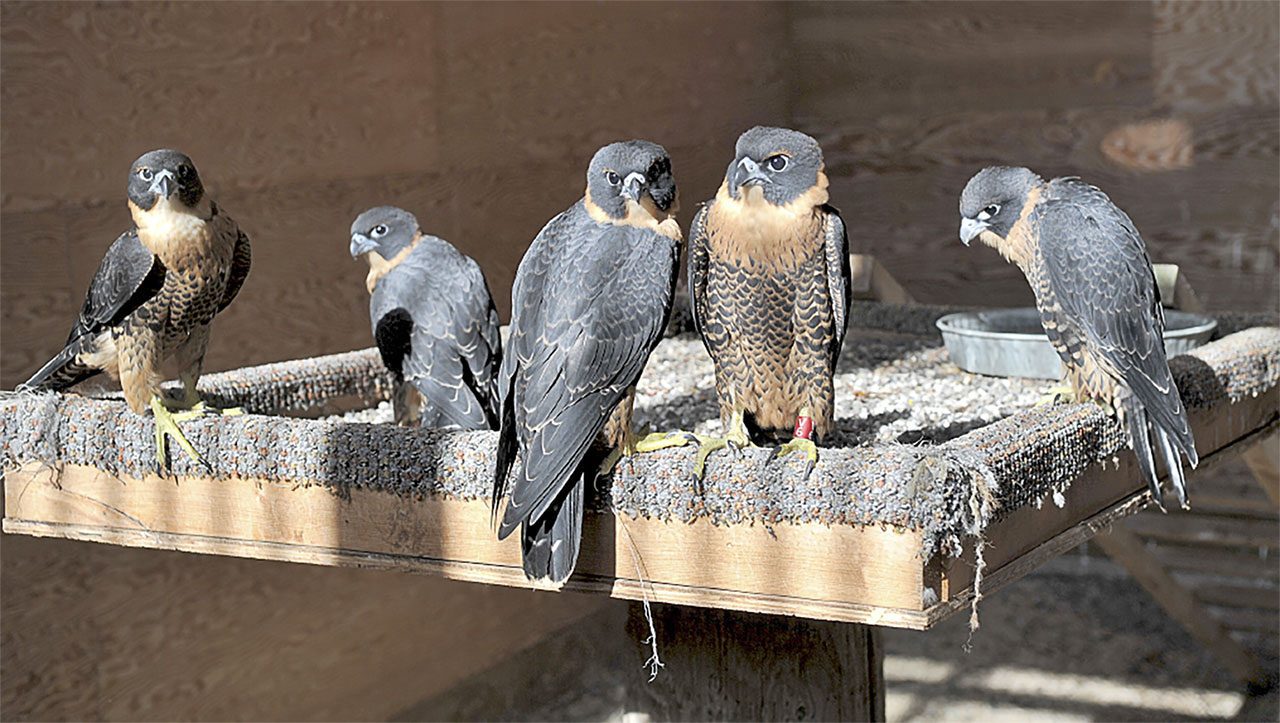
Restoration Program
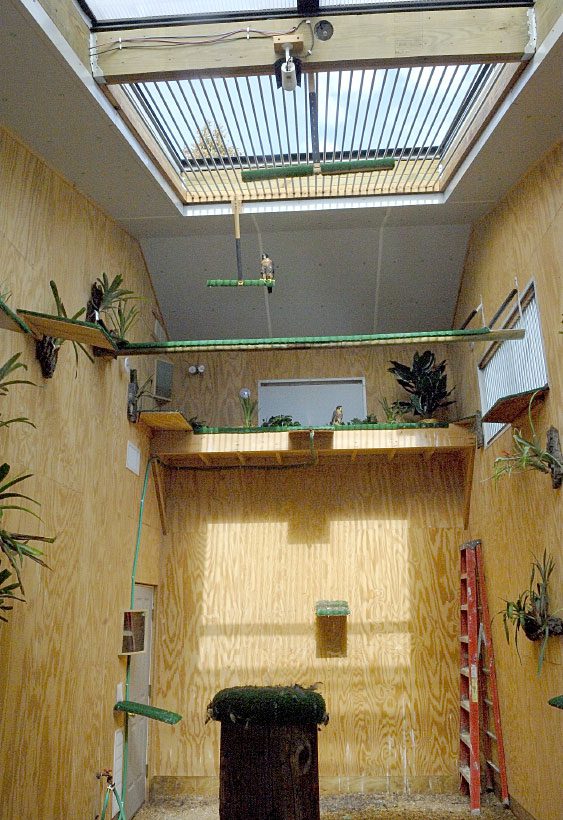
Captive-release programs are typically employed only as a lastditch effort when species have been extirpated from all or much of their former range. But we believe that active species rescue is preferable to watchful waiting. Our goal is to introduce unrelated captive-bred falcons to the local population. These individuals have the potential to enhance genetic variation, stabilize recruitment deficits, and help mitigate population declines. Because DNA fingerprinting indicates that the Orange-breasted Falcons in Central and South America are a single population without subspecies, the risk of introducing maladaptive genes into the population is minimal.
Our captive Orange-breasted Falcon colony consists of 28 birds—11 original founders from Panama, 4 from Belize (including 2 botfly-infested juveniles we rescued in 2012), and their captive-bred progeny. They are maintained in spacious climate-controlled aviaries in Wyoming. This species is very difficult to breed in captivity, despite the ease in breeding the related Bat Falcon and many other falcon species. Of the 56 young produced in captivity since 2006, all have been the product of artificial insemination. Thirty-nine have been released in the Mountain Pine Ridge area, including 5 in 2014; of these, 23 are thought to have become independent through 2013.
After 5 of the 13 captive-bred young we released in 2007-08 were killed by Black-and-white HawkEagles at our initial hack site, we moved the site to a prominent peninsula at the end of a high ridgeline, surrounded on three sides by steep 2,000-foot canyons, which provide escape routes for the young falcons if they are attacked by avian predators.
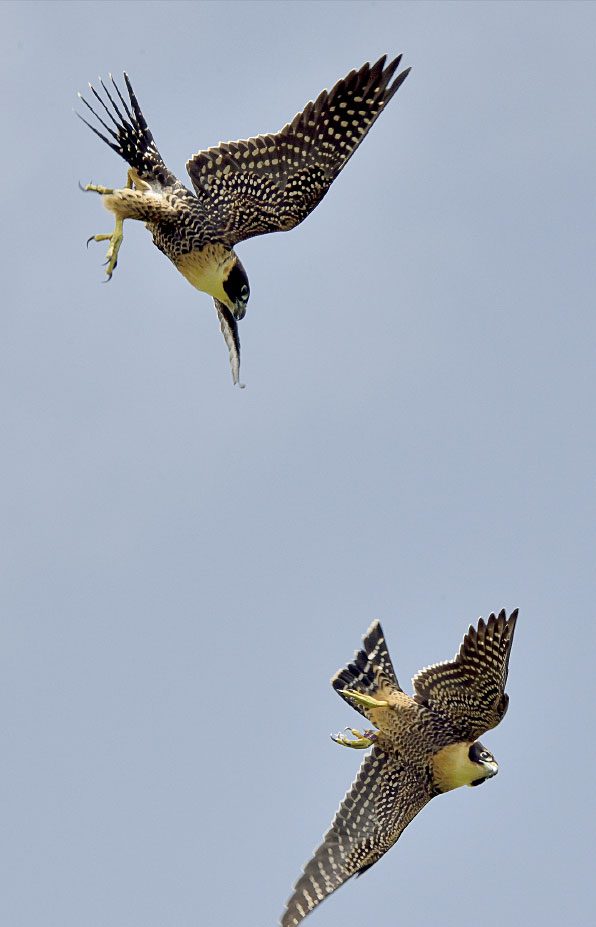
In mid-June, when the captive-bred juveniles are about 40 days old, the nonprofit conservation service LightHawk flies the fledglings to Belize along with some 900 frozen quail for the birds’ summer and fall rations. The falcons are immediately placed in a hack tower to acclimate them to their new surroundings. Within a few days they will take their maiden flights—the first in a series of perilous steps on their four-month journey to independence. The males fledge first and typically spend a day or two in the local pines before returning to the platform for food. They are most vulnerable to predation during their first few weeks of clumsy flying and exploration. Being hand raised in a group in the laboratory, they imprint on each other but are relatively unafraid of humans and manageable if they become lost in the rainforest. They wear a tiny radio-transmitter attached to their tarsus to aid in locating them.
Our hack-site attendants—typically college students exploring options for graduate school—care for the young falcons during daylight hours. Our role is to provide food, guidance, and protection. The attendants quickly identify and bond with each falcon through its vocalizations, wing beat, appearance, and unique personality. Some falcons are sociable and friendly; others are withdrawn, cautious, or even grumpy like a spoiled child. The attendants are like surrogate parents, initially hand-feeding and then guiding the development of essential social and hunting skills, many of which the birds seem to learn by trial and error and by watching their parents. The best part of my job as manager, apart from being there at the site, is to interpret the falcons’ behavior for the hack-site attendants and direct future activities in nightly emails.
Following their first week of exploration, the young falcons begin aerial games of chase, which soon become spectacular high-speed mock attacks. They also play keep away, plucking a pinecone or small stick from a tree, or catching a hapless butterfly or a giant flying grasshopper, and carrying it aloft, daring the others to “catch me if you can.” Following an intense pursuit, the prize is dropped, triggering a mad dive by the participants to retrieve it and renew the game. These chases are thrilling to watch as the falcons twist and dodge between the trees, flying at speeds comparable to that of a major league fastball pitch. Orange-breasted Falcons may be among the fastest falcons in the world. Although these games may look like play to us, they have deadly serious survival implications as the young falcons hone their hunting skills. Losing a meal struck down over the canopy could later mean the difference between life and death by starvation.
The young captive-bred falcons do not start hunting birds until the height of the fall passerine migration in September and October. The timing is similar with wild youngsters, which are entirely dependent upon their parents for food through early fall and beyond. Our feeding schedule mimics these natural parameters.
The Impossible Dream
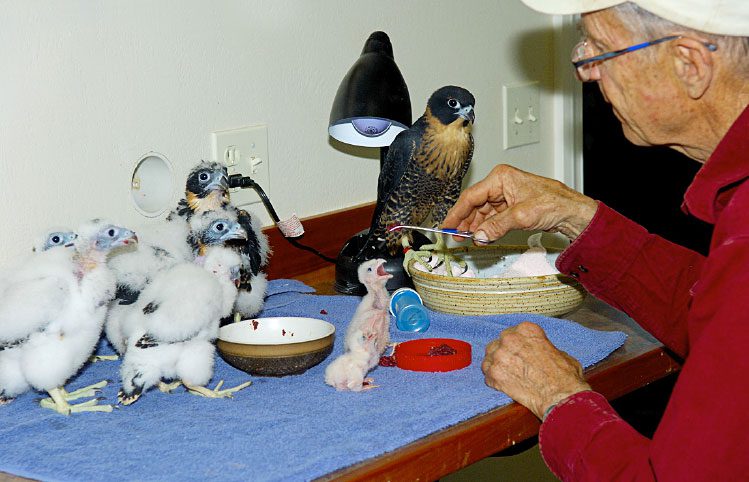
One of the five young captive-bred falcons released in 2010 (a blue-banded male with the letter-number combination B1) adopted the hack site as his personal territory the following year and has become the superstar of our program, giving us hope for the species. He stayed with us all summer long, playing, feeding with, and protecting the new crop of youngsters. He earned his keep by sounding a vocal alarm whenever danger threatened. He also led the juveniles in mock attacks against trespassing vultures, kites, Solitary Eagles, White Hawks, and Red-tailed Hawks, and was especially aggressive toward the occasional Black-and-white Hawk-Eagle. He tried to impose a territorial “no-fly zone.” The youngsters learned what to fear by his example.
In late June of the following year, a wild adult female visited the hack site. She returned many times during the next few months, sometimes with a plucked carcass for the fledglings. We named her “Caya.” She was seen in late October after the juveniles had dispersed, perched side by side with B1. This was exciting news— uncharted territory providing more questions than answers. Their behavior did not at first suggest a budding relationship. Were they attracted to the location, the free defrosted quail, the hacking youngsters, each other, all of the above, or none of the above? Coming from such diverse backgrounds, could they ever reconcile their differences? Surely Caya would choose a natural cliff for nesting, like the one from which she fledged. B1 was hatched in an incubator and raised by humans in a cardboard box. Could the two be enticed to nest in an artificial nest box? With the help of landowner George Headley and his crew, we installed a platform in a tall pine at the hack site with a nest box on top. Our plan was to lure B1 and Caya to feed in the nest box and become familiar with it. But Caya had other ideas. She had already selected a wellprotected ledge on a small cliff about 350 meters downslope from the hack site in a commanding location 300 nearly vertical meters above the river valley below. B1 adapted.
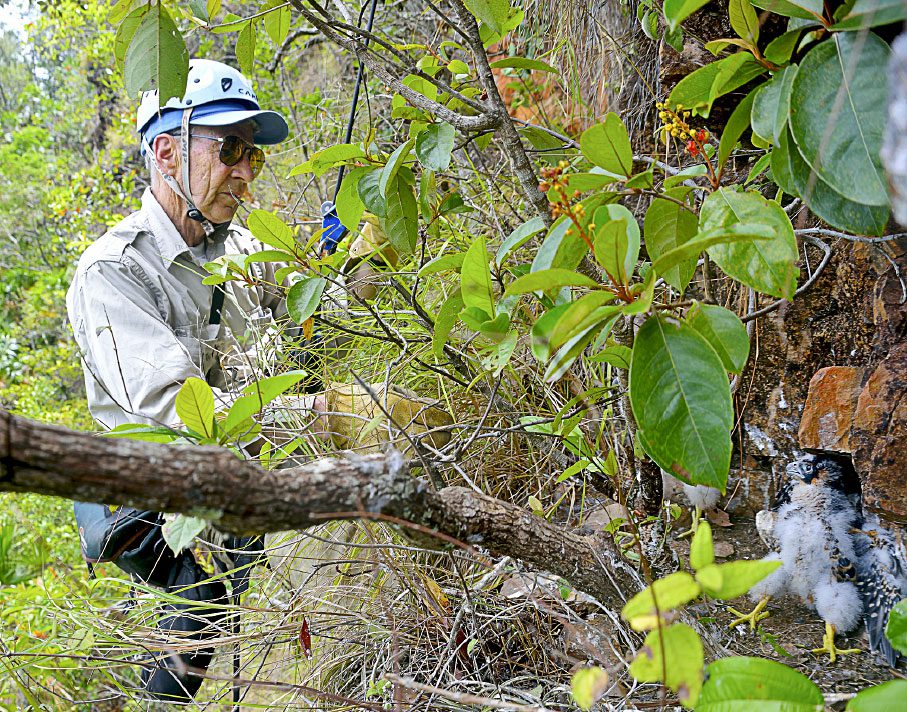
Caya and B1 fledged three beautiful youngsters, one more than any other eyrie in 2013. With the help of technical climber Matt Allshouse, I was able to rappel down the cliff and band the chicks—an impossible dream come true and one of my fondest memories. Both parents and the youngsters gravitated to the hack site shortly after fledging, joining four captive-bred juveniles for the summer in a large happy family group.
And the dream continued! E5, a second male released in 2010, paired with the resident female at the King Vulture Falls eyrie. She had lost her mate. They failed to produce young in 2012 but fledged two female chicks in 2013 (photo at the top of this article shows one of these juveniles). The fact that two of our captive-bred falcons bred successfully with wild females is unprecedented. Researchers had to release thousands of captive-bred Peregrine and Aplomado falcons over several decades to reestablish those species. Ours was a fortuitous beginning facilitated by a small extant wild population, but a beginning that suggests we are on the right track. Our captive-bred falcons can survive and breed successfully and have already introduced their unrelated genes into the dwindling population. But it also reminds us that the wild population is so small that two wild females were unable to find wild-born partners. Our hypothesis that new genetics will improve fitness and productivity is yet to be tested.
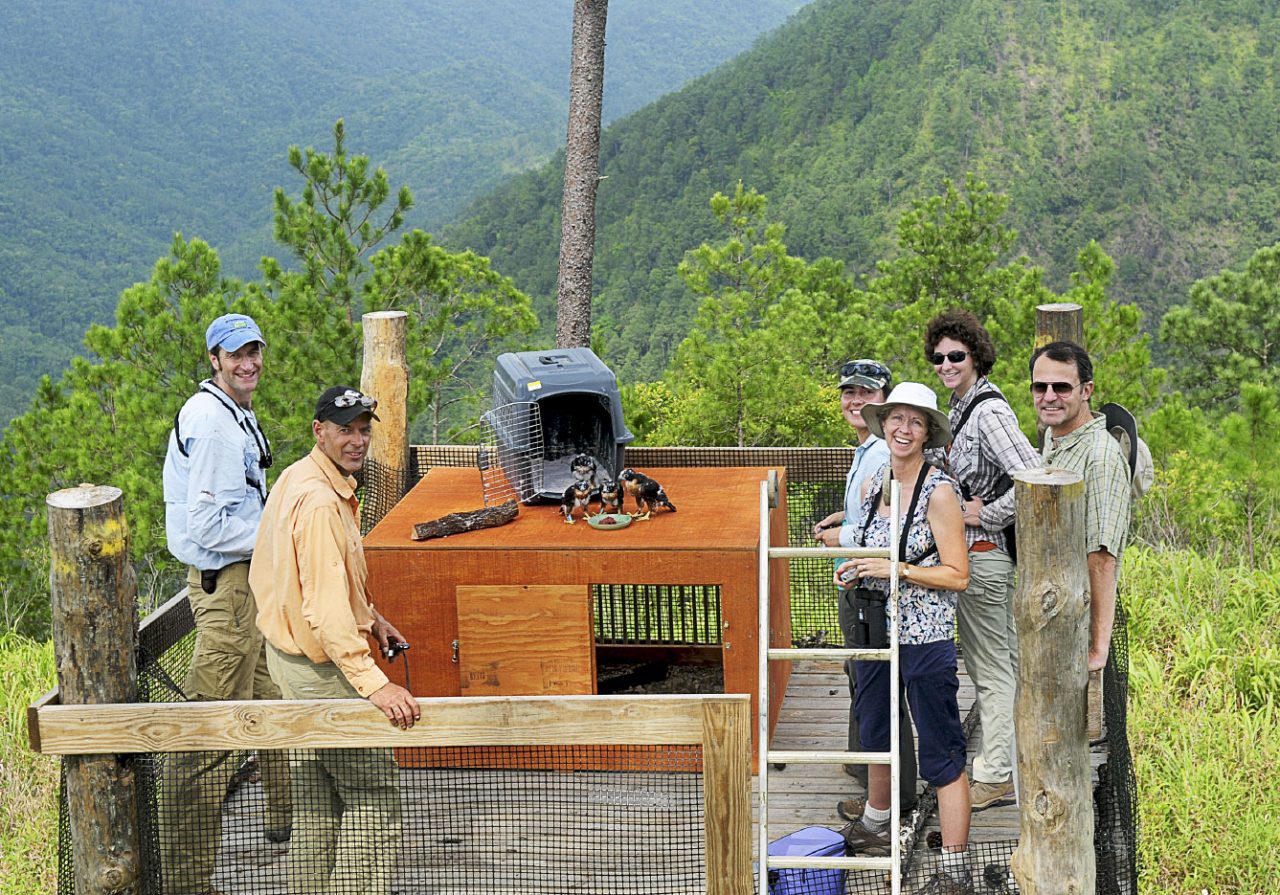
Life is ephemeral in the natural world of the tropics. Early in 2014, a wild male replaced captive-bred E5, presumed dead. The new pair appeared to be nesting, until our hopes were dashed by the loss of the resident female, found dead on the cliff. We were ecstatic when one of B1 and Caya’s 2013 youngsters filled the vacancy, another example of the precariously small population. Caya and B1 failed to produce young this year for unknown reasons. Nonetheless, B1 was at the hack site when I arrived with the 2014 crop of youngsters, and Caya appeared a short time later to help with the long, perilous hack.
Bittersweet Year
Although 2013 was a very good year, it was marred by the loss of three of seven young falcons—two captive-bred young and one of B1 and Caya’s youngsters. Overwhelming evidence points to predation by a Black-and-white Hawk-Eagle, the first such losses in five years of releases at the current hack site. Juveniles are vulnerable, especially when they are roaming the countryside. We witnessed one unsuccessful hawk-eagle attack, when one of the young falcons managed to dive into the canyon to pick up speed and maneuverability and escaped. In flat country, he would probably have been killed. Black-and-white Hawk-Eagles hunt unseen from the clouds, stooping like a falcon to surprise their victims before they can react or sound a warning alarm.
The fear of losing more young falcons was nerve-racking for hack-site attendant Audrey Martin, her assistant Sarah Moon, and our Belize researchers. Each passing day the juveniles became stronger and wiser, increasing their chances for survival. I asked everyone to guard the site closely, hoping that a visible human presence might deter attacks, and to search for the hawk-eagle from prominent vantage points. Without knowing the location of the hawk-eagle’s territory and its nesting status, we were at the bird’s mercy. After the third juvenile disappeared on August 3, we saw the hawk-eagle once more, this time pursued by a contingent of angry falcons. The four remaining youngsters dispersed on schedule. We suspect that the survivors learned how to avoid the hawk-eagle’s attacks.
We hope to begin the first natural-history study of the Black-and-white Hawk-Eagle with our partners at the Cornell Lab of Ornithology and University of Wyoming. We aim to use this knowledge to explore strategies to mitigate the predation of young falcons, which would have potential benefits for both species in a changing landscape that is becoming increasingly hostile to them. Both are flagship species in the tropical ecosystem and are of extraordinary interest to birders and other ecotourists.
Many authors have reflected on the Orange-breasted Falcon’s rarity throughout its range. We believe that its specialized habitat requirements, low reproductive rate, and predation by a plethora of natural enemies are the primary causes for its historic scarcity. More recently, the cumulative effects of habitat alteration, fragmentation, human conflicts, and increasing predation may explain the catastrophic reduction in the species’ range in Central America and its declining population. Given the species’ ecological challenges and its apparent isolation from the little-known population in South America, the extirpation of the small population in Belize and Guatemala seems increasingly likely.
Our research has revealed many of the Orange-breasted Falcon’s mysteries, and yet we have barely scratched the surface when it comes to fully understanding its population dynamics, the carrying capacity of its environment, its fecundity, longevity, and recruitment needs, the impacts of weather, parasites, and predators, and the consequences of anthropogenic activities. We are banding chicks to help analyze population viability and increasing fledging success by applying prophylactic treatments for parasites. We have experimented with vulture exclusion nest boxes, and we are enhancing genetic variation by introducing unrelated captive-bred falcons. But none of these initiatives is likely to succeed unless the local people embrace a strong conservation ethic. In partnership with the Cornell Lab of Ornithology and University of Wyoming, we are developing elementary school education programs in Central America, focusing on the important role of raptors in the environment. We are making a difference but our success will depend on public support and enlightened future management.
Robert B. Berry has been studying Orange-breasted Falcons since the early 1990s. A lifelong falconer, he played a significant role in the recovery of the North American Peregrine Falcon in the 1970s and ’80s.

All About Birds
is a free resource
Available for everyone,
funded by donors like you
American Kestrel by Blair Dudeck / Macaulay Library
